
nucleosynthesis proceeds in hot stellar plasmas mainly via Beta- decay and "slow" neutron capture (s-process) or via "rapid" neutron capture (r-process in exploding supernovae). At temperatures of about 30 keV (s) or above 100 keV (r-process) the atoms get highly ionized.
the atomic charge state q can significantly alter the Beta lifetime (the Fermifunction depends on q; orbital electron capture (EC) depends on number and orbit of bound electrons).
for HCI a "new" Beta decay mode, "bound beta decay", (Beta b) occurs with the electron bound in an inner shell (Fig.1, r.h.s.). There the decay energy is enlarged by about the electron binding energy; and the lifetime might alter drastically.
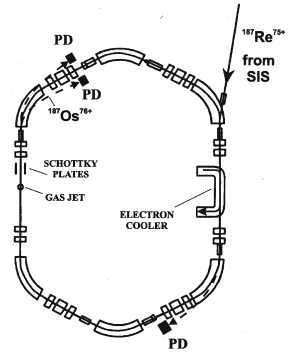
in ion storage rings/ion traps beta-unstable ions are preserved at a well-defined charge state for hours mainly due to electron cooling.
at GSI beta-unstable HCI are provided by either the fragmentseparator FRS or (if long-lived) by the synchrotron SIS and injected into the experimental storage ring ESR (Fig.2).
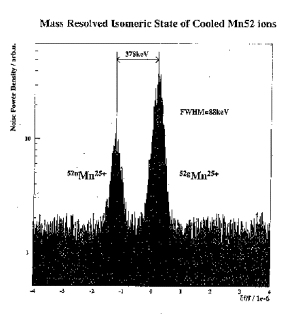
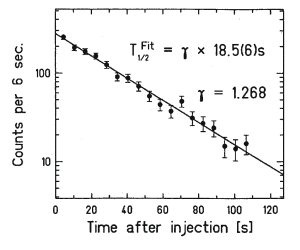
for electron-cooled ions (all of them get the same sharp velocity) there is a one-to-one correspondence between revolution frequency f, measured via Schottky noise spectroscopy (Fig.3), and mass-to-charge ratio m/q. Both, Beta+ and Beta- decays change the atomic charge state q by one unit and, therefore trajectory as well as revolution frequency f. The Beta-daughters may be recorded either by particle detectors (Fig. 2) or by Schottky spectroscopy.
Example: Beta+lifetime of bare 19Ne ions, measured by a detector moved into the ring aperture and recording the Beta+ daughters 19F (Fig.4). From a precise lifetime one gets the decay energy, the Fermifunction and the EC/Beta+ ratio.
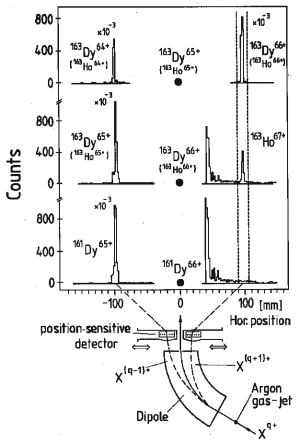
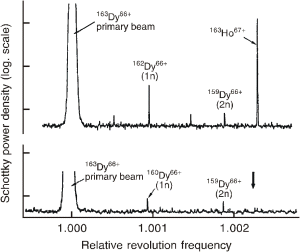
stored, bare 163Dy ions decay to hydrogen-like 163Ho by
Betab decay.
As the charge state q remains unchanged and as the mass difference of mother and
daughter is very small (decay energy only 50 keV), the daughter ions cannot be resolved by
Schottky spectroscopy (Fig.3).
"indirect" detection needed: stripping off the electron by turning on a gas jet , changing therewith charge state q and detecting the bare 163Ho ions by either a particle detector (Fig.5) or by Schottky spectroscopy (Fig.6).
result: the half-life of bare dysprosium gets 50 days, whereas neutral dysprosium is absolutely stable.
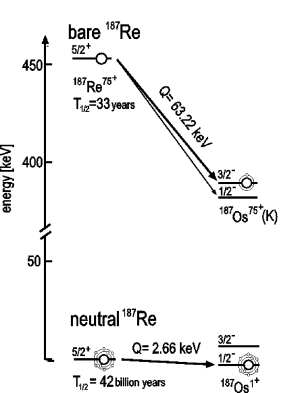
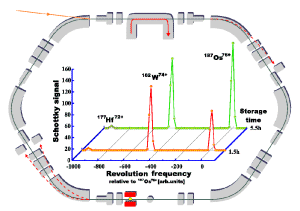
from the abundance ratio of 187Re and its Beta daughter 187Os and from the half-life of neutral 187Re (42 billion years) a lower limit for the age of our Milky Way galaxy – and a fortiori – for the age of the universe of 14 billion years can be derived.
during galactic history, however, 187Re – as all other nuclides – gets "astrated" into newly originating stars and might be, depending on location in the stellar plasma, highly ionized there. Then it can decay by Betab decay to the first excited state of 187Os (Fig.7). The half-life of bare 187Re has been determined in the ESR to 33 years only, that is by more than 9 orders of magnitude shorter than in the neutral charge state (Fig.8)
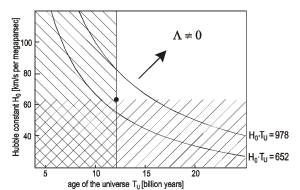
from the half-life of bare 187Re the half-lives for all charge states q can be reliably calculated. Within well-established models of the chemical evolution of our galaxis "lifestory" of 187Re can be modeled and the "effective" half-life determined. From it a lower limit of 12 billion years for the age of the universe has been derived.
the 12 billion years are corroborated by almost all "astronomical" clocks like globular clusters. Together with a new lower limit of 63 km/s and Megaparsec for the Hubble constant from the first observation of delta-Cepheids in the Virgo cluster, narrow constraints for the matter density in the universe follow which are in disagreement to the Einstein-de Sitter standard model, a universe with "critical" density (Fig.9).
[1] M. Jung et al., Phys. Rev. Lett. 69, 2164 (1992).
[2] F. Bosch et al., Phys.Rev. Lett. 77, 5190 (1996).